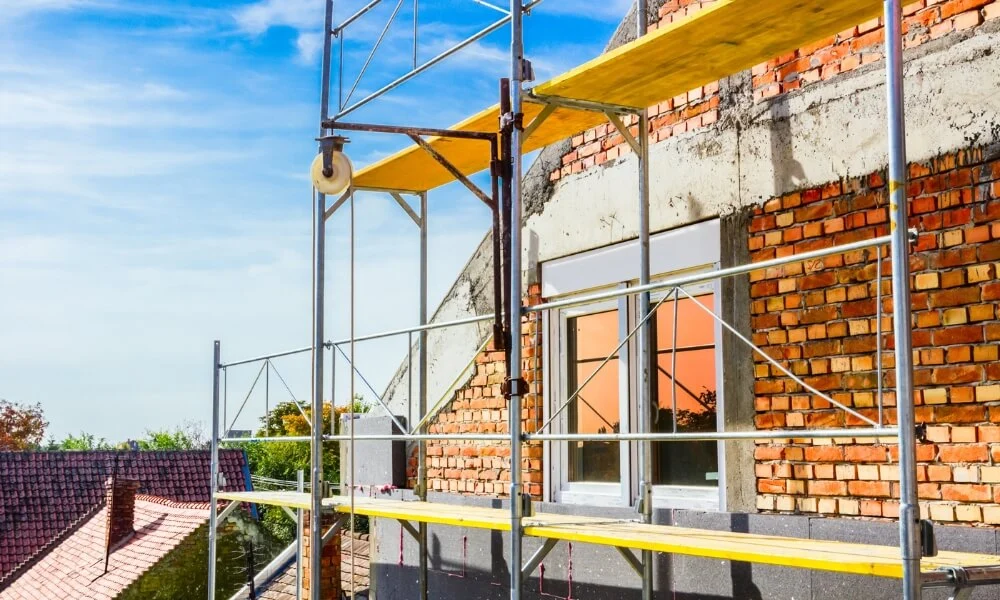The world of construction and maintenance often demands that workers operate at great heights. Here, scaffolding is a temporary yet sturdy structure providing a secure labor and materials platform. Scaffolding allows workers to reach lofty workspaces and contributes to the safety and efficiency of construction projects.
In this comprehensive guide, we’ll delve deep into the world of scaffolding. We’ll explore its various types, each serving different construction needs. More importantly, we’ll highlight the potential hazards associated with using scaffolding. No construction tool, however useful, is exempt from posing risks, and scaffolding is no exception.
Yet, risks and hazards do not define the utility of scaffolding. With proper precautions and safety measures in place, the dangers can be mitigated and controlled. Hence, we’ll also shed light on effective control measures that can enhance worker safety while maintaining the benefits of scaffolding on a construction site.
Whether you are a construction professional, a student in the field, or someone with a keen interest in understanding the complexities of construction work, this guide will offer a wealth of knowledge. So, buckle up and join us on this informative journey through the intricate world of scaffolding.
What is Scaffolding?
Scaffolding is a temporary structure used in the construction industry to support workers and their materials when working at heights above the ground. The word “scaffold” originates from the Latin “scapula,” meaning a stage or platform.
The primary purpose of scaffolding is to provide a safe working platform and access to hard-to-reach areas for the duration of construction, repair, or maintenance work. It can be used for various tasks, from painting and plastering to constructing multi-story buildings.
Scaffolds are typically made of metal or wood and consist of a platform or platforms supported by a framework. This framework can be fixed to a building or structure, or it can be free-standing. Some types of scaffolding can even be moved or adjusted to suit changing work conditions.
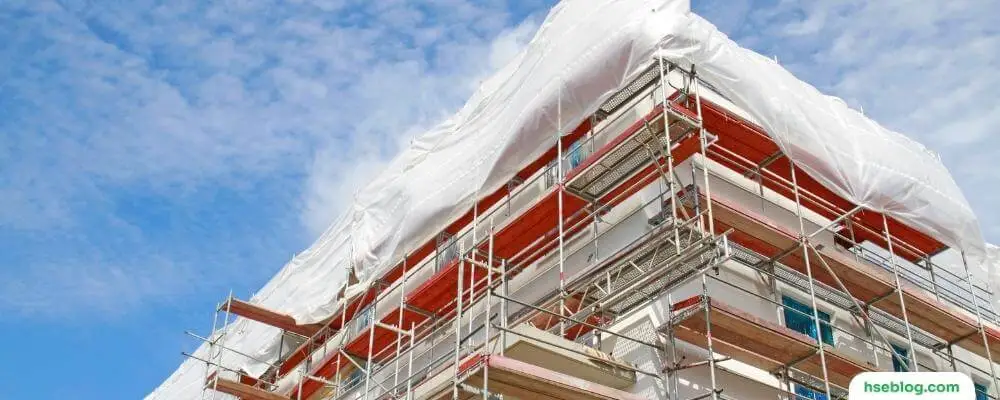
Scaffolding History
The history of scaffolding can be traced back to the early days of human civilization. The first use of scaffolding was in ancient Egypt, which was used to build the pyramids. Scaffolding was also used in ancient Greece and Rome and later became popular in Europe during the Middle Ages.
Scaffolding became increasingly important during the Industrial Revolution, as it was used to build the factories and other structures needed for the new industrial economy. Today, scaffolding is still an essential part of construction and is used worldwide.
Importance of Scaffolding
Scaffolding is an important part of the construction. It allows workers to safely reach high areas, supports materials during construction, and helps to protect workers and passersby from falling objects. Scaffolding can be found on tall buildings, bridges, and other structures.
Types Of Scaffolding
There are many different types of scaffolding, each with its own purpose. Some of the most common types of scaffolding include:
- Single Scaffolding
- Double Scaffolding
- Mobile Scaffolding
- Suspended Scaffolding
- Independent Tied Scaffolding
- Cantilever Scaffolding
- Trestle Scaffolding
- Tower Scaffolding
1. Single Scaffolding
Single scaffolding is a type of scaffolding that is used to support one side of a structure. It is commonly used in construction and renovation projects. Single scaffolding consists of two parts: the standards, which are the vertical supports, and the ledgers, which are the horizontal supports. The standards are connected to the ledgers using coupling devices. Single scaffolding is usually erected using scaffold tubes, clamps, and boards. It is important to note that single scaffolding must be used with a safety system, such as guardrails, to prevent accidents.
2. Double Scaffolding
Double scaffolding is a type of scaffolding that is used to support both sides of a structure. It is similar to single scaffolding but has additional standards and ledgers. Double scaffolding is often used in masonry work. It consists of two rows of standards connected by cross-bracing. The ledgers are connected to the standards using scaffold tubes, clamps, and boards. Double scaffolding must be used with a safety system, such as guardrails, to prevent accidents.
3. Mobile Scaffolding
Mobile scaffolding is a type of scaffolding that is mounted on wheels. It is commonly used in construction and renovation projects. Mobile scaffolding consists of two parts: the base, which is the platform that the workers stand on, and the tower, which is the frame that supports the base. Mobile scaffolding must be used with a safety system, such as guardrails, to prevent accidents.
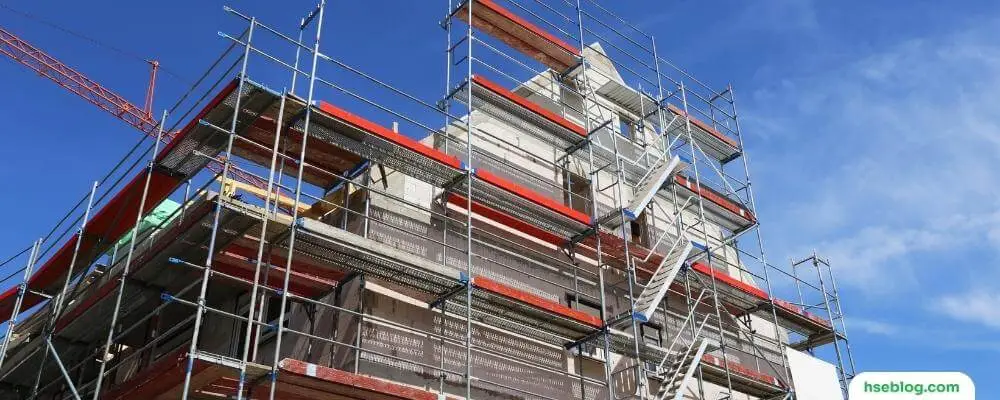
4. Suspended Scaffolding
Suspended scaffolding is a type of scaffolding that is hung from an overhead structure, such as a crane. It supports workers and materials during construction, repair, or demolition projects. Suspended scaffolding consists of a platform, which is suspended from ropes or cables, and a frame, which supports the platform. Suspended scaffolding must be used with a safety system, such as guardrails, to prevent accidents.
5. Independent Tied Scaffolding
Independent tied scaffolding is a type of scaffolding that is supported by its own weight. It is commonly used in construction and renovation projects. Independent tied scaffolding consists of two parts: the standards, which are the vertical supports, and the ledgers, which are the horizontal supports. The standards are connected to the ledgers using coupling devices.
Control Measures For The Erection Of An Independent Tied Scaffold
Possible control measures to be implemented when erecting an independent tied scaffold include ensuring that the scaffold is designed for its intended load and erected by a competent scaffold contractor on firm, level ground with base plates used to spread the load.
The scaffold components should be free from damage. The scaffolders should wear fall-arrest equipment during the assembly to prevent falls. The scaffold should be tied securely to the building with the appropriate number of ties to prevent collapse, considering possible loads and adverse weather conditions.
- Correctly designed for use and load.
- Designed for the weather.
- Equipment to be used.
- Stable ground.
- Base plates and sole plates.
- Scaffold was not damaged and is in good condition.
- Erected by competent persons.
- Inspected before use.
- Scaffolders wearing fall-arrest equipment.
- Securely tied to structure/ building.
- Protected from vehicles.
6. Cantilever Scaffolding
Cantilever scaffolding is a type of scaffolding that is supported at one end. It is commonly used in construction and demolition projects. Cantilever scaffolding consists of a platform supported by a frame at one end. The other end of the platform is free-hanging. To prevent accidents, cantilever scaffolding must be used with a safety system, such as guardrails.
7. Trestle Scaffolding
Trestle scaffolding is a type of scaffolding that is supported by trestles or horizontal supports. It is commonly used in construction and renovation projects. Trestle scaffolding consists of two parts: the standards, which are the vertical supports, and the trestles, which are the horizontal supports. The standards are connected to the trestles using scaffold tubes, clamps, and boards. Trestle scaffolding must be used with a safety system, such as guardrails, to prevent accidents.
8. Tower Scaffolding
Tower scaffolding is a type of scaffolding supported by towers or vertical supports. It is commonly used in construction and renovation projects. Tower scaffolding consists of two parts: the base, which is the platform that the workers stand on, and the tower, which is the frame that supports the base. To prevent accidents, tower scaffolding must be used with a safety system, such as guardrails.
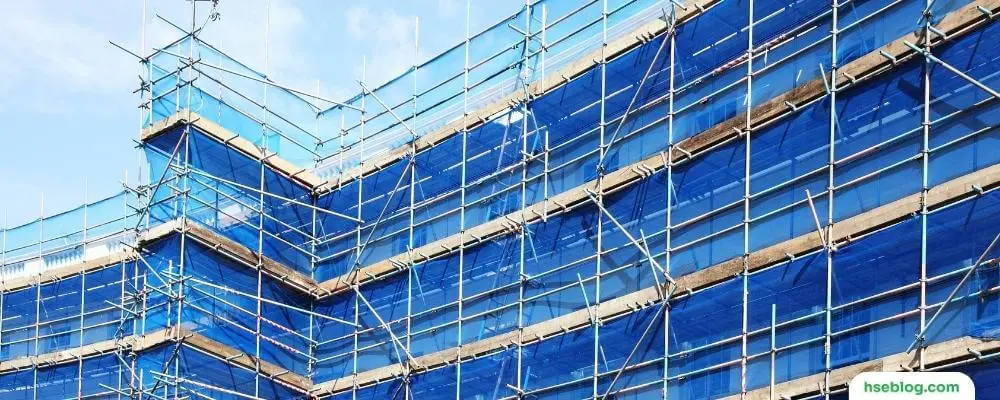
Major Hazards Associated With Scaffolding
Some hazards associated with scaffolding include falls, electrocution, being struck by falling objects, and being caught between the scaffold and another object.
- Fall Hazards: Falls from scaffolding are one of the most common accidents on construction sites. Workers can fall if they lose their balance, slip on a wet or icy surface, or are struck by a falling object.
- Electrocution Hazards: Workers can be electrocuted if they come into contact with power lines while working on scaffolding.
- Falling Object Hazards: Falling objects can strike and injure workers on the ground, as well as workers who are on scaffolding.
- Caught-Between Hazards: Workers can be caught between the scaffold and another object, such as a wall or equipment. This can result in serious injuries or even death.
- Collapse Hazards: Scaffolding can collapse if improperly constructed or maintained. This can result in serious injuries or death.
- Weather Hazards: Wind, rain, and snow can make scaffolding unsafe. High winds can cause scaffolding to collapse, while slippery conditions can increase the risk of falls.
- Lighting Hazards: Poor lighting can make it difficult for workers to see, increasing the risk of accidents.
- Equipment Hazards: Workers can be injured if they are struck by falling equipment or using defective equipment.
- Chemical Hazards: Workers can be exposed to hazardous chemicals when working with certain materials, such as paint or solvents.
- Working Alone Hazards: Workers working alone on scaffolding are at an increased risk of injury. If a worker is injured, it may be difficult for someone to come to their aid.
- Fatigue Hazards: Tired Workers are more likely to make mistakes, which can lead to accidents.
- Distraction Hazards: Workers can be distracted by work, other people, or equipment. This can increase the risk of accidents.
- Access and Egress Hazards: Workers can be injured while climbing up or down scaffolding. They may also be injured if they fall while trying to access or egress the scaffold.
- Housekeeping Hazards: Scaffolding can become cluttered with tools, debris, and other materials. This can create trip hazards and make it difficult for workers to move around safely.

Scaffolding Safety Control Measures
Several measures can be taken to ensure the safety of workers when using scaffolding, including:
- Fall Protection: Any scaffolding higher than four feet need protection. This could be a personal fall arrest system (such as harnesses, lifelines, and lanyards), safety nets, or guardrails. These measures ensure that even if workers lose their balance, they will not fall a significant distance.
- Unstable Base: Scaffolds must be constructed on a solid, firm surface. The ground should be level to prevent the structure from tilting or collapsing. If using a mobile scaffold, it’s crucial to lock it in place before starting work. You should avoid using unstable objects like barrels or boxes to support scaffolds as they can shift or collapse under the weight.
- Unsafe Planks and Decks: All scaffold planks and decks should be robust enough to bear the load of the workers and their materials. Check for signs of damage, such as cracks, holes, or splinters, that could weaken the plank or cause injury.
- Wobbly Scaffold: If a scaffold is unstable, it should not be used. Its four legs must firmly rest on a solid footing, and the braces should be tightly secured. Under no circumstance should a worker try to reach higher by standing on unstable objects such as chairs or stools atop the scaffold.
- Overloading: Every scaffold has a maximum load capacity, including workers’ combined weight, tools, and materials. Ensuring this capacity is not exceeded is essential, as it can lead to a collapse.
- Missing or Damaged Parts: Regular inspection of scaffolding parts is necessary. All parts, including base plates, cross braces, guardrails, and planking, should be in good condition. The scaffold should not be used until fixed if any part is missing or damaged.
- Unsafe Ladders: Ladders used with scaffolds must be properly maintained and secured. They should be free from any damage that could lead to a collapse. A ladder should be placed at a safe angle and secured at the top to prevent tipping.
- Falling Objects: Materials and tools should be securely fastened to prevent them from falling off the scaffold and injuring people below. If a tool or material begins to fall, it’s important not to try to catch it; instead, get out of its way.
- High Winds: Working on scaffolding during high winds is dangerous as it can lead to a collapse. Workers should wait until the wind dies down before using the scaffold.
- Lightning: Similarly, scaffolding should not be used during a thunderstorm as lightning strikes can cause a collapse or other serious hazards.
- Slippery Surfaces: Scaffolds can become slippery, especially when wet. Workers should wear shoes with good traction and avoid working on a wet scaffold until it has dried.
- Electrical Hazards: Working near power lines can be a risk of electrocution. Ensure the scaffold is at least ten feet away from any power lines.
- Improper Use: Scaffolding should only be used for its intended purpose. Workers should avoid risky behaviors like climbing guardrails or leaning out over the sides.
- Training: All scaffolding workers should receive proper training to use it safely.
- Inspections: Regular inspections are crucial. Any scaffold not inspected by a qualified person should not be used.
- Emergency Procedures: In an accident or emergency, workers should know the correct procedures, such as not trying to fix the problem themselves but getting to safety and calling for help.
- Safe Access And Egress: There should always be a safe method for workers to get on and off the scaffold, using stairs or an approved access point rather than a ladder.
- Personal Protective Equipment: Scaffold Workers should always wear proper protective equipment, including hard hats, safety glasses, and gloves.
- Housekeeping: Keep the scaffold and surrounding area clear of debris and unnecessary tools or materials to prevent trip hazards and falling objects.
- Away From Traffic Routes: Scaffolds should be set up away from traffic routes to prevent accidental collisions.
- Post-Incident Procedures: If someone is injured using a scaffold, workers should know to call for help rather than trying to move the injured person themselves.
- Lower Level Uprights: These supports can help prevent the scaffold from tipping over and should be present on all scaffolding setups.
- Handrails & Toeboards: These are important safety features that can prevent falls. Handrails provide something for workers to hold onto, and toeboards stop tools and materials from being accidentally kicked off the edge of the scaffold.
- Guardrails: These are barriers along the edges of the scaffold platform that can prevent workers from accidentally falling off.
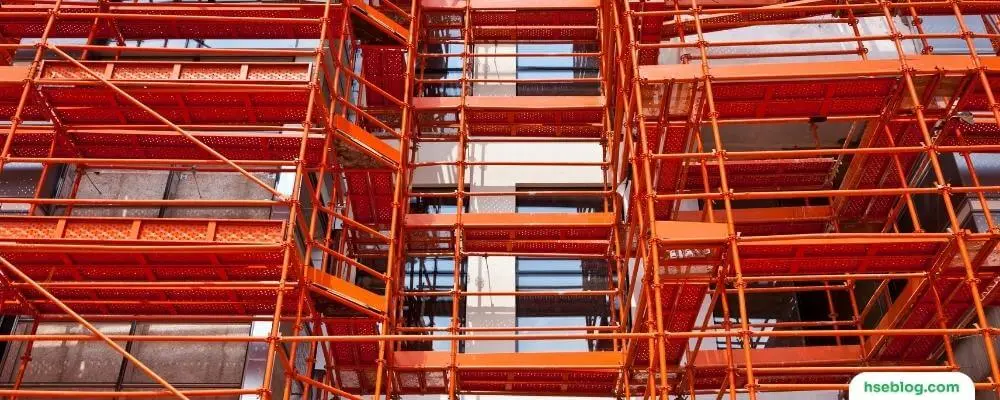
- Personal Fall Arrest Systems: These systems can catch workers if they fall, preventing them from hitting the ground.
- Safety Nets: Like personal fall arrest systems, safety nets can catch falling workers or tools, protecting people below.
- Ladders: Scaffolds should be equipped with safe and secure ladders to provide access and exit points for workers.
- Stairs: In some larger scaffolds, stairs should be installed to provide a safer and more comfortable way for workers to ascend and descend.
- Properly Braced: Scaffolds must be braced correctly and secured to the building or structure they’re servicing. Improper bracing can cause instability and lead to the scaffold tipping over.
- Trained Operators: Only workers trained in the safe operation of scaffolds should be allowed to use them.
- Maintenance & Inspection: Regular maintenance and inspections should be carried out to identify and fix any defects or hazards.
- Certification: Scaffolds should be certified by a qualified professional to ensure they meet all safety requirements.
- Safe Work Practices: Workers should always follow safe work practices, including adhering to the scaffold’s intended use, following the manufacturer’s instructions, and not removing any safety devices.
- Head Protection & Foot Protection: Proper protective gear, such as hard hats and closed-toe shoes or boots, should always be worn when working on a scaffold.
- Tools and Materials: Tools and materials should be properly maintained, and defective items should not be used. Loose clothing, which could catch on parts of the scaffold and cause a fall, should be avoided.
These safety control measures, when adhered to, can greatly reduce the risks associated with working on scaffolding, ensuring a safer working environment for all involved.
Conclusion
In conclusion, scaffolding, a vital component in many construction projects, requires meticulous planning and implementation to ensure safety and efficiency. This exploration into the various types of scaffolding, their components, associated hazards, and the measures to control these risks has highlighted the significance of scaffolding as more than just supportive structures or access providers. They carry substantial responsibility, involving everyone from scaffold builders and inspectors to the workers who utilize them daily.
It’s essential to pay heed to every aspect, from the scaffold’s base to the materials used in planks and decks, to prevent accidents and foster a safe work environment. Regular inspections, appropriate worker training, and the use of personal protective equipment are crucial in this endeavor. Adherence to these comprehensive control measures helps avoid incidents and creates an efficient and successful project execution environment. Being informed and proactive can make a world of difference in scaffolding safety.

